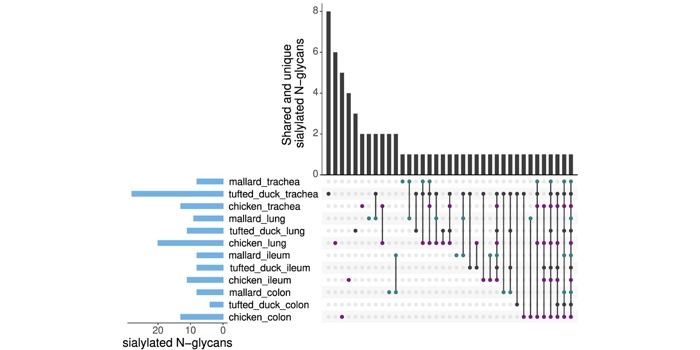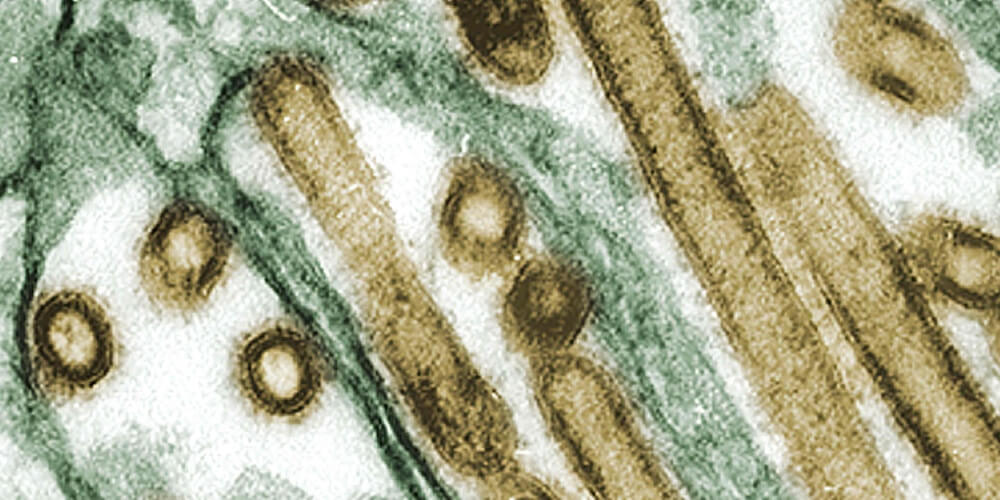New study increases understanding of receptor incompatibility in transmission of influenza A virus between species
Published: 2024-05-21

When a novel variant of the influenza A virus (IAV) emerges, it results in an influenza outbreak if immunity within human population is low. Rapid rates of interpersonal transmission and high rates of infection can result in such an IAV becoming a global pandemic. Studies have indicated that the three most recent IAV pandemics (H2N2 1957 Asian flu, H3N2 1968 HongKong flu, and H1N1 2009 Swine flu) were all caused by zoonotic viruses; they all contain genetic material from avian influenza viruses (AIVs). The exact transmission route from bird to human remains unclear, but each of the pandemics probably involved spread from wild to domestic bird species, and then to mammals (e.g. pigs and humans).
Normally, interspecies transmission is prevented by various mechanisms, including the host surface protein recognising the virus as foreign, and differences in pH levels. Research on barriers for interspecies transmission of IAVs has long focused on the linkage conformation of sialic acid-containing glycans, which serve as receptors for IAVs. Specifically, α2-3-linked sialic acid has been termed “the bird receptor” whilst α2-6-linked sialic acid has been termed “the human receptor”. However, recent glycomics research has shown that both structures are abundant in e.g. the respiratory tract tissues of both pigs and humans.
In a recent article in Glycobiology, researchers from the Zoonosis Science Center at Uppsala University, in collaboration with colleagues from University of Gothenburg Sahlgrenska Academy, Sahlgrenska University Hospital, and Max Planck Institute of Animal Behavior (First author: Jonas Nilsson, Proteomics Core Facility, University of Gothenburg; Corresponding author: Patrik Ellström, Uppsala University), used glycoproteomics to study the repertoires of glycan structures expressed in birds. The researchers studied putative sialic acid-containing glycan receptors for IAVs in three species: mallard, chicken, and tufted duck. The three species were chosen due to their different roles in the zoonotic ecology of IAVs. In mallards, the intestinal tract is the main site of IAV replication, whilst the respiratory tract is more often affected in chickens. Infection seems to be rare in tufted ducks, but this species is vulnerable to highly pathogenic IAV strains. In nature, the fecal-oral transmission route is likely the predominant one, whereas airborne transmission is more common in crowded poultry stocks.
Nilsson and colleagues performed glycoprotein analysis on tissue specimens to study how the expression patterns of sialylated glycans varied between the species. Epithelial cells from several potential IAV target organs (trachea, lung, ileum, and colon), were collected from healthy animals. Trypsin digestion and hydrophilic interaction liquid chromatography (HILIC) were used to enrich the glycopeptides, and individual peptide samples were analysed using nano-liquid chromatography–tandem mass spectrometry (LC-MS/MS). An Orbitrap Fusion Tribrid mass spectrometer (Thermo Fisher Scientific) was used for analysis. Tandem MS/MS (MS2), and MS/MS/MS (MS3) helped the researchers to identify glycan structures at specific glycosylation sites on the glycoproteins, and to discriminate α2-3- from α2-6-linked terminal sialic acids. In brief, the glycoproteomics analysis showed that the avian respiratory and intestinal tracts from all three species produced complex α2-3- and α2-6-linked sialic acid N-glycans. This included α2-3-linked sialyl Lewis structures, as well as both N- and O-glycans terminated with both α2-3- and α2-6-linked sialic acid. These findings were in contrary to previous reports stating that complex sialic acid-containing structures were mammalian-specific. Nilsson and colleagues suggest that available receptors in mammals and birds are more closely related than previously thought. In addition, the authors also detected the recently identified putative IAV receptor structures, mannose-6-phosphate (Man-6P) N-glycopeptides, in all tissues of the three bird species.
In conclusion, the findings of Nilsson and colleagues showed that sialylated glycan structures that were previously thought to be specific to mammals are present in at least three avian species. These results may have major implications for understanding receptor incompatibility and how IAVs are spread between birds and other species. In a broader perspective, these findings may also provide important clues for zoonotic ecology.
“We were surprised to see so many similarities in the glycan expression patterns between the three bird species and to previously published data from pigs and humans." says Patrik Ellström, corresponding author for the study. “These findings lead us to suggest that other factors than the linkage (α2-3- or α2-6-) between sialic acid and its underlying structure may be more important barriers for interspecies transmission. Such barriers could be secreted mucins serving as decoy receptors, availability of relevant proteases and other host factors.”
Data and code availability
The mass spectrometry proteomics data have been deposited to the ProteomeXchange Consortium via the PRIDE partner repository (Perez-Riverol et al., 2019), with the dataset identifier PXD036263.
Article
Nilsson, J., Eriksson, P., Naguib, M. M., Jax, E., Sihlbom, C., Olsson, B-.M., Lundkvist, Å., Olsen, B., Järhult, J. D., Larson, G, Ellström, P. (2024) Expression of influenza A virus glycan receptor candidates in mallard, chicken, and tufted duck. In: Glycobiology (Vol. 34, Issue 3, cwad098).
Funding
The glycoproteomics analysis was performed at the Proteomics Core Facility, Sahlgrenska Academy, Gothenburg University, with financial support from SciLifeLab and BioMS (Swedish National Infrastructure for Biological Mass Spectrometry).
Infrastructure
The Clinical Proteomics Facility and the Data Centre at Science for Life Laboratory (SciLifeLab) were used for parts of this study.
